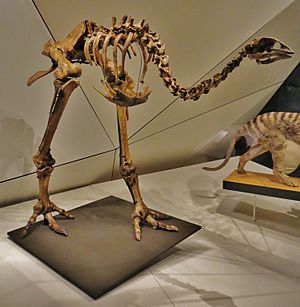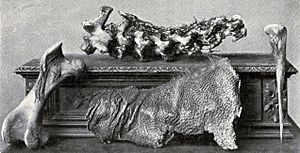Eastern moa facts for kids
Quick facts for kids Eastern moaTemporal range: Pleistocene-Holocene
|
|
|---|---|
 |
|
| Skeleton in Musee des Confluences, Lyon | |
| Conservation status | |
| Scientific classification | |
| Genus: |
Emeus
|
| Species: |
crassus
|
| Synonyms | |
|
List
Dinornis crassus Owen, 1846
Syornis crassus (Owen 1846) Hutton 1891 Euryapteryx crassus (Owen 1846) Hutton 1896 non Benham 1910 Dinornis casuarinus Owen, 1846 Dinornis huttonii Owen, 1846 (male) Emeus huttonii (Owen 1879) Oliver, 1930 Megalapteryx huttoni (Owen 1879) Rothschild 1907 Dinornis major (Hutton, 1875) Dinornis rheides (Owen, 1851) Cela rheides (Owen 1850) Rothschild 1907 Dinornis casuarinus Oliver 1846 Emeus casuarinus (Oliver, 1930) Syornis casuarinus (Owen 1846) Reichenbach 1850 Anomalopteryx casuarina (Owen 1846) Lydekker 1891 Mesopteryx casuarina (Owen 1846) Parker 1895 Meionornis casuarinus (Owen 1846) Hutton 1896 Cela casuarinus (Owen 1846) Rothschild 1907 Mesopteryx didina Hutton 1893 non Dinornis didinus Owen 1883 Meionornis didinus (Hutton 1893) Hutton 1896 non Dinornis didinus Owen 1883 Meionornis Haast, 1874 Mesopteryx Hutton, 1891 Syornis Reichenbach, 1850 |
|
The eastern moa, also known as Emeus crassus, was a type of moa that is now extinct. This means it no longer exists anywhere on Earth. When scientists first found bones of this bird, they thought they were three different species. They named them under the group Dinornis.
Later, scientists realized these were all the same type of bird. They decided to put them into their own group called Emeus. Today, Emeus crassus is the only species in this group. Scientists also discovered that what they thought were different species were actually male and female eastern moa. The females were about 15-25% larger than the males. This is common in some birds, like kiwis.
What did the Eastern Moa look like?
The eastern moa was a medium-sized bird. It could stand between 1.5 and 1.8 meters (about 5 to 6 feet) tall. Like all moa, it had no wing bones, so it could not fly. Its body was covered in feathers that looked more like hair, which were beige.
It had a long neck and strong, powerful legs. Its feet were very wide compared to other moa. This made it a slow-moving bird. Scientists have found many parts of the eastern moa. These include single bones, full skeletons, and even soft parts like cartilage and skin. Near its head, the feathers became shorter, almost like coarse hair. Its head was probably bald.
Where did the Eastern Moa live?
Eastern moa lived only on the South Island of New Zealand. They preferred to live in low-lying areas. These areas included forests, grasslands, sand dunes, and shrublands.
Sadly, when humans arrived in New Zealand, they hunted the eastern moa. Because the birds were slow and couldn't fly, they were easy to catch. Like almost all moa species, the eastern moa became extinct by the year 1500.



